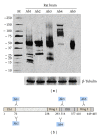Alternative splicing generates different parkin protein isoforms: evidences in human, rat, and mouse brain
- PMID: 25136611
- PMCID: PMC4124806
- DOI: 10.1155/2014/690796
Alternative splicing generates different parkin protein isoforms: evidences in human, rat, and mouse brain
Abstract
Parkinson protein 2, E3 ubiquitin protein ligase (PARK2) gene mutations are the most frequent causes of autosomal recessive early onset Parkinson's disease and juvenile Parkinson disease. Parkin deficiency has also been linked to other human pathologies, for example, sporadic Parkinson disease, Alzheimer disease, autism, and cancer. PARK2 primary transcript undergoes an extensive alternative splicing, which enhances transcriptomic diversification. To date several PARK2 splice variants have been identified; however, the expression and distribution of parkin isoforms have not been deeply investigated yet. Here, the currently known PARK2 gene transcripts and relative predicted encoded proteins in human, rat, and mouse are reviewed. By analyzing the literature, we highlight the existing data showing the presence of multiple parkin isoforms in the brain. Their expression emerges from conflicting results regarding the electrophoretic mobility of the protein, but it is also assumed from discrepant observations on the cellular and tissue distribution of parkin. Although the characterization of each predicted isoforms is complex, since they often diverge only for few amino acids, analysis of their expression patterns in the brain might account for the different pathogenetic effects linked to PARK2 gene mutations.
Figures




Similar articles
-
Parkin transcript variants in rat and human brain.Neurochem Res. 2004 Sep;29(9):1715-24. doi: 10.1023/b:nere.0000035807.25370.5e. Neurochem Res. 2004. PMID: 15453267
-
Increasing the Coding Potential of Genomes Through Alternative Splicing: The Case of PARK2 Gene.Curr Genomics. 2014 Jun;15(3):203-16. doi: 10.2174/1389202915666140426003342. Curr Genomics. 2014. PMID: 24955028 Free PMC article.
-
Differential expression of PARK2 splice isoforms in an in vitro model of dopaminergic-like neurons exposed to toxic insults mimicking Parkinson's disease.J Cell Biochem. 2018 Jan;119(1):1062-1073. doi: 10.1002/jcb.26274. Epub 2017 Aug 23. J Cell Biochem. 2018. PMID: 28688199
-
Parkin-associated Parkinson's disease.Cell Tissue Res. 2004 Oct;318(1):175-84. doi: 10.1007/s00441-004-0924-4. Epub 2004 Jul 30. Cell Tissue Res. 2004. PMID: 15503153 Review.
-
[Etiology and pathogenesis of Parkinson's disease: from mitochondrial dysfunctions to familial Parkinson's disease].Rinsho Shinkeigaku. 2004 Apr-May;44(4-5):241-62. Rinsho Shinkeigaku. 2004. PMID: 15287506 Review. Japanese.
Cited by
-
NeuroArray: A Customized aCGH for the Analysis of Copy Number Variations in Neurological Disorders.Curr Genomics. 2018 Sep;19(6):431-443. doi: 10.2174/1389202919666180404105451. Curr Genomics. 2018. PMID: 30258275 Free PMC article.
-
In Silico Analysis of SNPs in PARK2 and PINK1 Genes That Potentially Cause Autosomal Recessive Parkinson Disease.Adv Bioinformatics. 2016;2016:9313746. doi: 10.1155/2016/9313746. Epub 2016 Dec 29. Adv Bioinformatics. 2016. PMID: 28127307 Free PMC article.
-
A customized high-resolution array-comparative genomic hybridization to explore copy number variations in Parkinson's disease.Neurogenetics. 2016 Oct;17(4):233-244. doi: 10.1007/s10048-016-0494-0. Epub 2016 Sep 17. Neurogenetics. 2016. PMID: 27637465 Free PMC article.
-
Expression pattern of parkin isoforms in lung adenocarcinomas.Tumour Biol. 2015 Jul;36(7):5133-41. doi: 10.1007/s13277-015-3166-z. Epub 2015 Feb 6. Tumour Biol. 2015. PMID: 25656612
-
Proteomic Analysis of Parkin Isoforms Expression in Different Rat Brain Areas.Protein J. 2016 Oct;35(5):354-362. doi: 10.1007/s10930-016-9679-5. Protein J. 2016. PMID: 27601173
References
-
- Bonifati V. Autosomal recessive parkinsonism. Parkinsonism and Related Disorders. 2012;18(supplement 1):S4–S6. - PubMed
-
- Lücking CB, Dürr A, Bonifati V, et al. Association between early-onset Parkinson's disease and mutations in the parkin gene. The New England Journal of Medicine. 2000;342(21):1560–1567. - PubMed
-
- Oliveira SA, Scott WK, Martin ER, et al. Parkin mutations and susceptibility alleles in late-onset Parkinson's disease. Annals of Neurology. 2003;53(5):624–629. - PubMed
MeSH terms
Substances
LinkOut - more resources
Full Text Sources
Other Literature Sources
Medical

